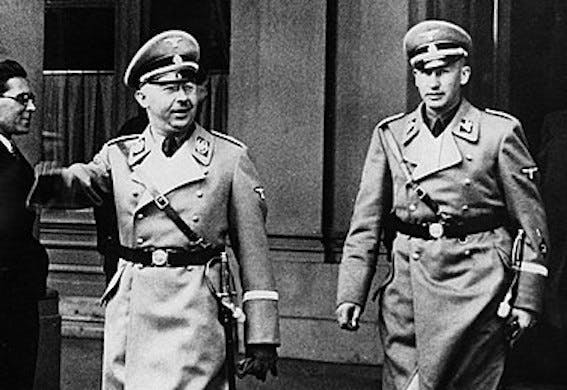A Great Achievement of Biography Takes Us Inside the Belly of Nazism
That Dougherty was a woman and that she spoke fluent German are crucial. Much of the book is about the biographer’s effort to pin down Reinhard Heydrich’s wife.

‘The Hangman and His Wife: The Life and Death of Reinhard Heydrich’
By Nancy Dougherty
Knopf, 656 pages
In the 1990s, I would meet Nancy Dougherty at the National Arts Club occasionally to talk shop about biography and her work on Reinhard Heydrich, one of the architects of the Holocaust. I would always come away feeling privileged to know about a magnificent book in the making.
Dougherty died in 2013 as a result of early-onset Alzheimer’s. She had completed a draft of her book, and two editors took over: the late Christopher Lehmann-Haupt of the New York Times Book Review and Victoria Wilson of Knopf. My earliest impressions have been confirmed: This is one of the great achievements of biography.
It was begun in 1950, when 11-year-old Nancy Dougherty saw firsthand the bombed remains of Cologne, Germany. She became a trained sociologist, and in the book shows exactly how Heydrich fit into the Nazi hierarchy. It is difficult to explain her approach to biography without extensive quotation:
“Sociologists have found that almost no one is equally gifted at acting effectively and at explaining why action was necessary in the first place. Since both arts are essential to the smooth running of an organization, they are usually performed by different leaders. Heydrich, the junior partner and former staff officer, had built his career on getting things done: aggressive, decisive, fast-moving, brusque, he never pretended to be a philosopher. It was Himmler who represented the SS on Party Day or Hitler’s birthday and he who felt compelled to teach his minions the New Order’s new version of the knightly virtues. Although the two men had collaborated to create the complicated machinery of murder, they behaved very differently when called on to justify it. While Heydrich evaded the whole problem, Himmler walked straight toward it, embracing the hopeless task of speaking the unspeakable.”
What makes the individual important, why differences in personality matter, are on display everywhere in this searching book.
That Dougherty was a woman and that she spoke fluent German are crucial. Much of the book is about the biographer’s effort to pin down Heydrich’s wife, Lina, who an earlier, male biographer told Dougherty was “confused.” That man did not understand that the supposed confusion was evasion.
On several visits to Lina Heydrich, Dougherty pressed and pressed and pressed, wanting Lina to say how much Heydrich knew about the Holocaust. Lina usually responded by saying her husband was second to Himmler and not really that important. When Doughtery’s questions became unbearable, Lina would say she had something to attend to in the kitchen. Oh, Doughtery replied, let me help you.
No male biographer, I dare say, could have so easily, in German, pursued her subject. If Lina never did admit just how involved her husband was in his administration’s evil causes, her very effort to avoid hard truths tells us much about how millions could be murdered so long as those in charge, and those close to them, did not inquire too closely into what was going on.
Heydrich’s last days are vividly re-enacted. Called “the butcher of Prague,” the tall, blond, Aryan-looking Reich Protector of Bohemia and Moravia believed in his invincibility, driving around in an open car with a light security detail. Warned against such folly, he believed that, in the end, the people of Czechoslovakia would thank him for instituting many social reforms. The government in exile engineered his assassination.
Ironies abound in this biography, including Heydrich’s belief that he could be “hard” (using torture and murder) so that he could later be “soft” and create a welfare state. His prowess as an athlete and his forbidding demeanor deflected rumors that his grandmother was Jewish (never proven). He was a stalwart supporter of the National Socialist family while frequenting brothels and engaging in romantic affairs.
The complications and contradictions of Heydrich’s character come into play every time Dougherty’s interviews his wife. Lina Heydrich’s silences, anger, rationalizations, and occasional truth-telling are all sorted out in this canny biography, so that we get the living presence of Nazism and understand how it was that such evil was perpetuated with a perverted sense of doing good.
It does no good to just call Nazis monsters, and “The Hangman and His Wife” shows us why.
Mr. Rollyson began his study of Nazism in 1966 with his first publication: “Tyranny: Survival in Auschwitz, One Day in the Life of Ivan Denisovich,” Honors College Essays, Michigan State University

